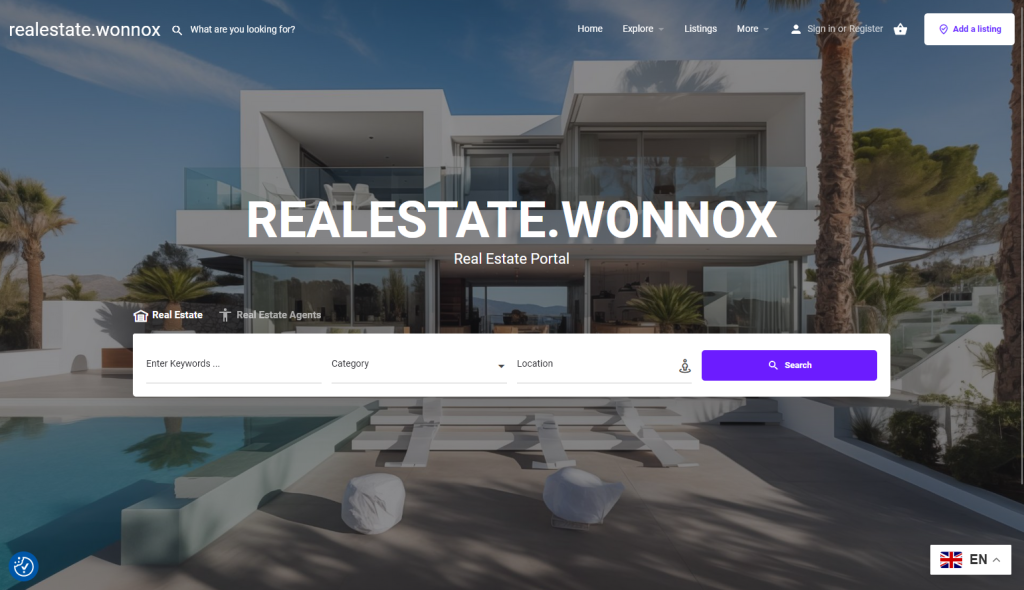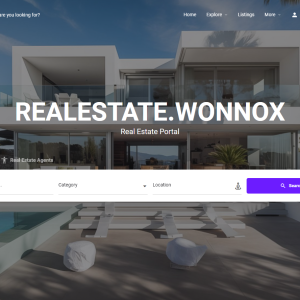
- Direct message
- Leave a review
- Bookmark
- Share
- Report
- prev
- next
Description
A real estate listing or profile in a web directory under the "real estate" category should provide a comprehensive overview of a property, making it appealing to potential buyers, renters, or investors. An effective listing goes beyond basic details to showcase the property’s features, surrounding amenities, and unique selling points. Below is a detailed breakdown of the features that should be included in such a listing, structured to fit a 1030-word description:
1. Property Overview (130 words)
Property Type: Clearly specify the type of property, such as single-family home, apartment, condominium, townhouse, or commercial space.
Address: Provide the full address, including street name, city, state, and ZIP code, for location identification.
Price: Display the asking price, indicating whether it is negotiable or fixed.
Listing Date: Include the date the property was listed, giving potential buyers context about how long it has been on the market.
Square Footage: State the total living area of the property, often measured in square feet or square meters.
Lot Size: Mention the size of the land the property occupies, essential for buyers interested in outdoor space.
Year Built: Indicate when the property was constructed, providing insight into its age and style.
2. Detailed Property Features (170 words)
Number of Bedrooms: Specify how many bedrooms the property has, highlighting if they have special features like walk-in closets or en-suite bathrooms.
Number of Bathrooms: List the total number of bathrooms and indicate if they include full, half, or powder rooms.
Living Spaces: Describe additional living spaces such as a living room, family room, den, or home office.
Kitchen Features: Highlight key kitchen attributes, including modern appliances, countertop materials (e.g., granite, quartz), and cabinetry styles.
Flooring: Mention the types of flooring throughout the property, such as hardwood, tile, or carpet.
Heating and Cooling: Provide information on the HVAC system, including types of heating (e.g., central, radiant) and cooling (e.g., central air, window units).
Special Features: Note any unique features, such as vaulted ceilings, fireplaces, skylights, or energy-efficient systems.
3. Exterior Features (130 words)
Curb Appeal: Describe the property’s exterior appearance, including architectural style and landscaping.
Parking Options: Mention available parking, such as a garage, carport, driveway, or street parking, and the number of vehicles it accommodates.
Outdoor Spaces: Highlight outdoor features like patios, decks, balconies, pools, gardens, or fenced yards.
Additional Structures: Note any additional buildings on the property, such as sheds, guest houses, or workshops.
Roof Type and Condition: Provide details about the roofing materials used and the general condition of the roof.
Landscaping: Describe landscaping features, including trees, shrubs, flower beds, or irrigation systems.
Fencing and Privacy: Mention any fencing around the property for added security or privacy.
4. Neighborhood and Location (150 words)
Community Overview: Describe the neighborhood, including its vibe (e.g., family-friendly, urban, suburban, or rural).
Proximity to Amenities: List nearby amenities such as grocery stores, shopping centers, parks, schools, and healthcare facilities.
Public Transport: Provide information about public transportation options, such as bus or subway lines and their proximity to the property.
Schools: Highlight local schools and their ratings, which is particularly important for families.
Safety and Crime Rates: Mention the safety of the neighborhood, including any relevant crime statistics or community initiatives.
Recreation Opportunities: Describe nearby recreational facilities, such as sports fields, gyms, walking trails, or recreational centers.
Future Development: Note any upcoming developments in the area that may impact property value, such as new schools, shopping centers, or public transport expansions.
5. Visuals and Multimedia (150 words)
High-Quality Photos: Provide a gallery of high-resolution images showcasing the property’s interior and exterior from multiple angles.
Floor Plans: Include detailed floor plans illustrating the layout, dimensions, and flow of the living spaces.
Virtual Tours: If available, offer a virtual tour or video walkthrough of the property to give potential buyers an immersive experience.
Drone Photography: Utilize aerial photos to showcase the property’s size, layout, and surrounding landscape.
Neighborhood Photos: Include images of nearby amenities, parks, and community features to give context about the location.
3D Models: If applicable, offer 3D models of the property for an enhanced viewing experience.
Before and After Photos: For renovated properties, include before and after photos to showcase improvements made.
6. Real Estate Agent Information (120 words)
Agent Name: Provide the name of the listing agent or agency representing the property.
Contact Information: Include the agent’s phone number and email address for easy communication.
Agency Website: Link to the agency’s website for additional resources or to view other listings.
Social Media Links: Provide links to the agent’s or agency’s social media profiles for potential buyers to follow for updates.
Agent Bio: A brief bio of the agent, highlighting their experience, specialties, and successful track record in real estate.
Professional Designations: Mention any relevant certifications or designations the agent holds, such as Realtor® or Accredited Buyer’s Representative (ABR).
Customer Reviews: Include a few testimonials or ratings about the agent’s services from previous clients.
7. Financing and Offer Details (130 words)
Financing Options: Describe available financing options, such as conventional loans, FHA loans, or VA loans, to assist potential buyers in understanding their payment options.
Down Payment Information: Provide information on recommended down payment amounts or assistance programs that may be available.
Offer Details: Specify if the seller is open to negotiations or if there are any specific terms for offers.
Closing Costs: Briefly explain expected closing costs and whether the seller is willing to cover some or all of these expenses.
Incentives: Mention any incentives offered by the seller, such as covering closing costs or including appliances or furniture in the sale.
Contingencies: Outline any contingencies related to the sale, such as financing, inspections, or the sale of another property.
Open House Information: Include details about upcoming open house events for interested buyers to view the property.
8. Property History (90 words)
Previous Owners: Indicate the number of previous owners and provide insight into the property’s history.
Renovations and Updates: Mention any significant renovations or updates made to the property, including dates and details about the work done.
Sale History: Provide information about the property’s sale history, including previous sale prices and dates.
Zoning Information: Specify zoning details that may affect the property’s use, such as residential, commercial, or mixed-use zoning.
Inspection Reports: Mention if inspection reports are available, allowing potential buyers to review the property’s condition.
9. Legal and Compliance Information (80 words)
Disclosure Statements: State whether the property is accompanied by disclosure statements detailing any known issues or repairs needed.
HOA Information: If applicable, mention whether the property is part of a Homeowners Association (HOA), including fees and regulations.
Property Taxes: Provide information about annual property taxes and whether they are current.
Easements and Rights: Discuss any easements or rights of way that may affect the property.
Building Codes: Note any building codes or regulations that must be adhered to.
10. Call to Action (70 words)
Schedule a Viewing: Encourage potential buyers to schedule a viewing or contact the agent for more information.
Make an Offer: Invite interested parties to make an offer or ask about the purchasing process.
Contact for Questions: Reiterate the importance of contacting the agent with any questions or for additional details about the property.
Follow on Social Media: Encourage visitors to follow the agency or agent on social media for updates on new listings or real estate tips.
11. Community and Lifestyle Highlights (90 words)
Local Culture: Describe the local culture and community atmosphere, highlighting unique aspects that may appeal to potential buyers.
Dining and Shopping: Mention nearby restaurants, shopping districts, and entertainment options, enhancing the appeal of the location.
Community Events: Provide information about local events, festivals, or farmers’ markets that foster community engagement.
Lifestyle Considerations: Discuss lifestyle aspects such as walkability, public transportation availability, or outdoor activities, catering to specific buyer needs.
Future Growth: Highlight any potential developments or improvements in the area that may enhance property value or community appeal.
This comprehensive structure ensures that a real estate listing in a web directory is thorough, appealing, and informative. It highlights the property's strengths, local amenities, and the expertise of the real estate agent, making it a valuable resource for potential buyers or renters.

Add a review